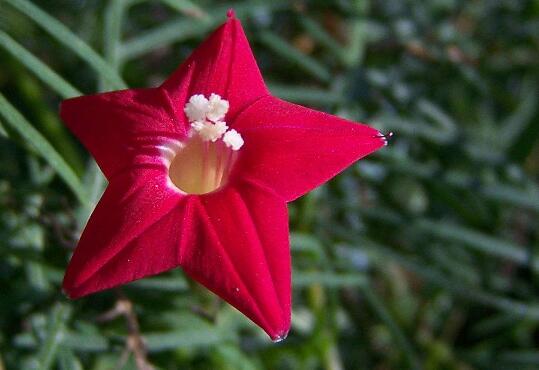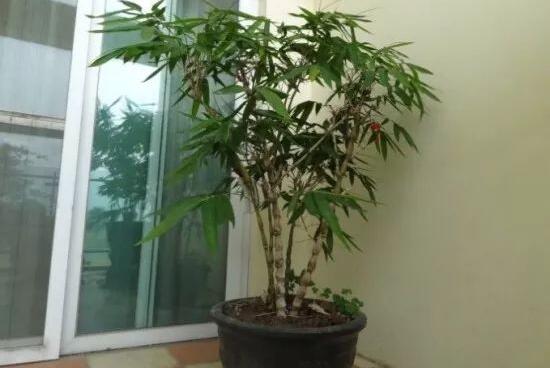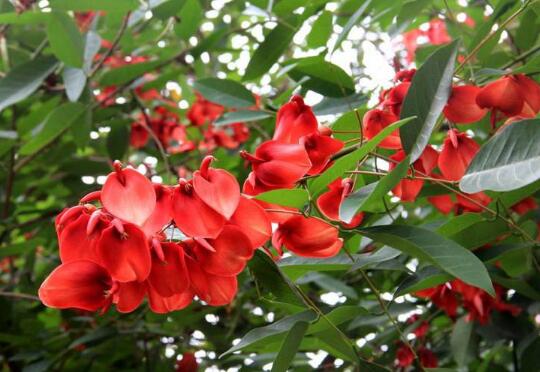How to raise five-star flowers, the breeding methods and points for attention / sufficient light
Five-star flower is a kind of flower plant native to tropical Africa and Arab regions. it was introduced to China, and now it can be seen in all provinces in our country, but if we want to raise it well, there are many places we need to pay attention to. How to raise five-star flowers? What are the breeding methods and matters needing attention of five-star flowers? Next, the editor will take you to learn about it.
First, how to raise five-star flowers and understand their habits

If we want to know how to grow the five-star flower, we must first understand its growth habits. This plant likes light, so we should keep it in sufficient light during its growth period, so that the plant can grow better. In addition, we also need to pay attention to the daily water and fertilizer management. The details are below. Let's take a look at them.
2. Culture methods and matters needing attention of five-star flower
1. Soil, peat soil
When we cultivate five-star flowers, it is best to use sterile, slightly fertilized and well-drained peat soil with a pH value of 6.5-6.8, which can avoid iron poisoning and magnesium deficiency. If the pH value is lower than 6.0, the plant will stop growing due to severe leaf edge cauterization due to iron poisoning.
two。 Temperature, night temperature above 17-18 ℃ / daily temperature above 22-24 ℃
When we breed the five-star flower, the ambient temperature is also what we need to pay attention to, because only if we let it grow at a suitable temperature, it can grow better. During the growth period, we should keep the night temperature above 17-18 ℃ and the daily temperature above 22-24 ℃. The temperature below 10 ℃ will make the flowering irregular and delay or hinder the blooming of flowers.
3. Fertilization, once every 7-10 days
Fertilizer is one of the main nutrients in the growth process of five-star flower, especially after entering the growing period, the demand for fertilizer is very high. Basically, we need to apply fertilizer every 7-10 days, so that the plant can grow better. When applying fertilizer, we should release thin fertilizer, not too high concentration, otherwise it is easy to burn the plant.
4. Moisture should not be overwatered
The five-star flower plant is relatively drought-tolerant, so we don't need to water it too frequently when we breed it. We should maintain the principle of "no dry, no watering, watering thoroughly", keep the soil slightly moist, and remember not to overwater it. Otherwise, it will make the plant yellowing, the flowers will grow slowly, and if you water too much, it will cause the root system of the plant to rot.
5. Light, light should be sufficient
The five-star flower is a light-loving plant, so we should keep it in sufficient light when we breed it, so that it can better carry out photosynthesis, so that the plant will grow better and more healthily. In the process of the growth of the five-star flower, it can be said that the stronger the light, the closer and stronger the plant will grow, and if the light is not enough, it will cause poor plant growth and malaise.
6. Timely treatment of diseases and insect pests
In the process of raising five-star flowers, if we are not careful enough, it is easy to let diseases and insect pests enter while they are empty. This kind of problem is very harmful to plants, so we must deal with it in time after we find it. However, because the treatment methods of each kind of diseases and insect pests are different, the editor will not introduce them to you one by one in this category. For details, you can refer to the article on pest control of five-star flowers.
How to raise starry flowers? Culture methods and matters needing attention of Flowers
Star flower, also known as five-star flower, is an erect or extroverted subshrub of the genus Rubiaceae. The flowering period of starry flowers is long, the flowers are rich in color, and the flowers are small and gather to form balls, which are of high ornamental value and are often potted indoors. So, how to raise starry flowers? The breeding methods and matters needing attention of star flowers are introduced as follows.
Picture: starry flowers
I. Culture methods of starry flowers
1. Pots: the flowers can be transplanted in pots 7-9 weeks after sowing. The suitable diameter of flowerpots is 10-15cm. One seedling can be planted in 10cm pots and two seedlings can be planted in 15cm pots. Before potting, appropriate fertilization should be applied to make the plant grow strongly so as to reduce the impact on the plant.
two。 Medium: the cultivation medium of Flower uses peat soil with aseptic, slightly fertilizer and good drainage, and the pH value is 6.5-6.8, in order to avoid iron poisoning and lack of magnesium. If the pH value is lower than 6.0, the plant will stop growing due to severe leaf edge cauterization due to iron poisoning.
3. Temperature: warm and sunny enough contribute to the growth of starry flowers. During the growth period, the night temperature should be kept above 17: 18 ℃, the daily temperature should be above 22: 24 ℃, and the temperature below 10 ℃ will make the blossom irregular and delay or hinder the blooming of flowers.
Picture: starry flowers
4. Lighting: stars and flowers like the environment with sufficient sunshine, the stronger the light is, the tighter and stronger the plant is, so in the winter of weak light and short days, we should pay attention to replenishing the light.
5. Moisture: the star flower is more resistant to drought, but not resistant to water and moisture. During the growth period, excessive watering should be avoided, and stagnant water in the cultivation medium should be avoided so as not to induce root rot. When watering, the water temperature should not be too low (that is, the water temperature should be consistent with the medium temperature). Excessive watering often yellowes the plant and slows the growth of flowers.
6. Fertilization: one week after planting, 800-1000 times of chlorophyllin was applied, once every 7-10 days. When the plant enters the middle stage of growth (that is, the plant height is 8-10 cm), 800-1000-fold solution of "flowering essence" can be applied once a week to promote flower bud differentiation and growth.
Picture: starry flowers
Matters needing attention in the cultivation of starry flowers
1. When the plant has 3 or 4 pairs of true leaves, the heart can be removed once after planting, so as to make the branches neat and blossom consistent.
two。 Star flowers generally only pick the heart once, if the flowering is expected to be too early, you can pick the heart twice, each picking will delay flowering for 10-12 days.
3. The cultivation time of 10cm flowerpot and 15cm flowerpot is 110cm and 120,140 days respectively.
[editor's conclusion] the starry flowers are colorful and gorgeous, and the general flowering period is from March to October, which is very ornamental. The above introduces the breeding methods and matters needing attention of star flowers, hoping to help you!
The culture method of five-star flower
The culture method of five-star flower
The basic information of five-star flower
Scientific name: Pentas lanceolata
Alias: Egyptian star flower, star flower, umbrella flower, herbal elixir.
Families and genera: Rubiaceae, five-star flower genus. Evergreen vegetation or subshrub, 30-60 cm tall. Stem erect or prostrate proximally, basal Lignification. Leaves opposite, lanceolate or ovate, ca. 9 cm, hairy. Flowering mainly from autumn to winter, other times can also bloom; Cymes terminal, flowers small, tubular, Corolla 5-lobed star, often dozens of clusters, with lavender, blue-purple, white, pink, red and other colors. Capsule. Seeds numerous, extremely small.
The five-star flower is small but has many flowers and a long flowering period. when the conditions are right, the flowers are often undefeated in the four seasons, and the flowers are like stars all over the sky, like small umbrellas open on top, delicate, delicate and gorgeous, strong in nature and easy to reproduce. It is a kind of flower which is very suitable for balcony and window sill.
[propagation of five-star flower] cutting and sowing. Mainly by cutting propagation.
The main results are as follows: (1) Cuttage is carried out in the growing period, and April cutting is the best. Select the unflowered branches and cut the cuttings with 2-8 cm, 2-3 nodes and slightly biennial parts.
Keep the substrate and environment moist after cutting, and cover 50% to 70% of the sun. It can take root in about 20 days, and it is very easy to survive. If the cuttings were soaked in 0.1%-0.2% indole acetic acid for 2-3 seconds, the rooting time could be shortened. It can also be cut in autumn.
(2) sowing: in April. Because the seed is small, it needs to be mixed with fine sand before sowing. The suitable temperature for germination was 21 °C, kept the bed soil moist and high air relative humidity after sowing, and germinated after 14 ~ 21 days. It takes 16 to 22 weeks from sowing to flowering.
[key points of five-star flower cultivation]
The main results are as follows: (1) temperature: like warmth, it can continue to grow and bloom above 15 °C, and the optimum temperature for growth is 20 °C to 30 °C. It is not cold-tolerant, the plant goes into dormancy when it is lower than 10 °C, it should be kept above 10 °C for overwintering, and the fallen leaves will die when it is below 5 °C. Resistant to high temperature, can grow and blossom normally under slightly shaded conditions at high temperature.
(2) Light: like the sun, sensitive to light, the flowering period needs 80% to 100% sunlight, which is conducive to plant growth and flowering. There should be more than 4 hours of direct sunlight every day. Too much concealment will lead to overgrowth of branches, thinness of plants, yellowing of leaves, difficulty in flowering or poor flowering. However, when the summer sun is strong, it needs proper shade, and too much light will make the plant not easy to blossom. Plenty of sunshine should be given at other times. But try to accept the sun sooner or later, should cover about 30% of the sun.
(3) watering: afraid of drought, like wet soil environment. During the peak period of growth, flowering and summer, water should be fully supplied to keep the basin soil moist. But avoid basin soil wet waterlogging, watering during the growing period to master "dry and wet phase". The plum rainy season should be checked in time and the stagnant water in the basin should be emptied. Watering should be controlled in winter, especially after flowering in autumn and winter, there will be a dormant period of 1 month on the left and right, which requires controlled watering, as long as the basin soil is slightly wet.
(4) Environmental humidity: if the weather is fine and dry during the high temperature in summer, water should often be sprayed to the branches and leaves and around them, so as to increase the relative humidity of the air and be beneficial to the growth and flowering of the plant.
(5) fertilization: during the period of growth and flowering, fertilizer with the combination of nitrogen, phosphorus and potassium should be applied once a month to facilitate continuous growth and flowering. Because of its strong adaptability and rapid growth, it is not suitable to apply too much nitrogen fertilizer, otherwise the plants will grow too long and blossom sparsely, which will affect the ornamental plants. Fertilization should be combined with pruning, that is, after each flowering, the residual flowers should be cut off and fertilizers should be supplied in time to promote the germination of new branches and continue to bloom. If the overwintering temperature can be maintained above 15 °C and the plant continues to grow and blossom, fertilizer should be applied once every semimonthly; if the temperature is low and the plant goes into dormancy, fertilizer should be stopped.
(6) pruning: coring should be carried out at the seedling stage when it grows to about 10 cm, in order to promote branching and more flowering. Picking the heart should be carried out on a sunny day, and it is easy to cause wound festering when it is continuously overcast and rainy. The branches that are too long should be cut at any time during the growth period. if there are no seeds, the branches and leaves can be trimmed moderately after flowering, and the residual flowers can be cut off so as not to consume nutrients, keep the plant round, promote new buds and continue to bloom.
(7) upper basin and turning basin: when the seedlings are as high as 15-20 cm, they are planted in the basin with a diameter of 15-20 cm. The basin should be turned once every two years, which should be carried out in spring and autumn. For the slightly acidic soil which is fertile, loose and well drained, the best pH is 6.0-6.5, and the matrix can be prepared with peat soil, rotten leaf soil, garden soil and plain sand. After 2-3 years of pot planting, the growth potential of the plant decreased obviously, which should be eliminated and renewed.
(8) pest control: there are diseases and insect pests such as leaf spot disease and whitefly.
[common problems in five-star flower cultivation]
The common causes of common problems are thin plants, yellow leaves, no flowering or small and small flowering ① lack of light; lack of fertilizer ②; ⑤ plants grow for many years and become weak branches and leaves hypertrophy, but less flowering is due to excessive application of nitrogen fertilizer or simple application of nitrogen fertilizer
- Prev

How to trim Podocarpus, how to trim Podocarpus bonsai/3 strokes cut out the perfect shape
As a beautiful green plant, Podocarpus is often made into potted plants and kept at home. However, indoor cultivation of Podocarpus, if allowed to grow naturally, often long disorder, affecting the overall appearance. This needs to be solved through construction. How to prune Podocarpus? The following is the method of pruning Podocarpus bonsai
- Next

How to raise paulownia flowers, breeding methods and precautions of paulownia flowers / avoid stagnant water / avoid bright light
Paulownia flower is a kind of flower plant native to tropical America, which was introduced to China and can be seen in many cities in China. However, it is not easy to raise it well. There are many things we need to pay attention to. How to raise paulownia flowers? What are the culture methods and matters needing attention of paulownia flower
Related
- Fuxing push coffee new agricultural production and marketing class: lack of small-scale processing plants
- Jujube rice field leisure farm deep ploughing Yilan for five years to create a space for organic food and play
- Nongyu Farm-A trial of organic papaya for brave women with advanced technology
- Four points for attention in the prevention and control of diseases and insect pests of edible fungi
- How to add nutrient solution to Edible Fungi
- Is there any good way to control edible fungus mites?
- Open Inoculation Technology of Edible Fungi
- Is there any clever way to use fertilizer for edible fungus in winter?
- What agents are used to kill the pathogens of edible fungi in the mushroom shed?
- Rapid drying of Edible Fungi

